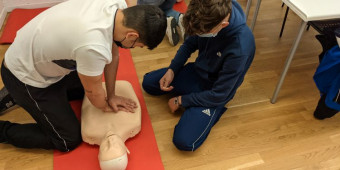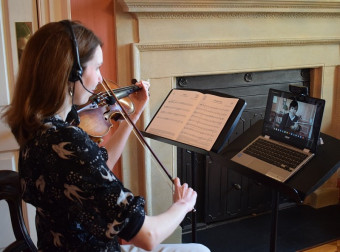
About a few weeks ago, I found the Etudier en France course on Coursera that is at a B1-B2 level.
I hadn’t completed a Coursera course for many years and when I saw this, I thought it was time to get back into it again. If you do a search on MOOCs (massive open online courses) on this website, you’ll see that I have written a lot about these over the years. I’m a great fan of them but know they’re not well liked by my peers in corporate Learning and Development.
Of course, they have their pros and cons, and I get that. Ultimately, I see MOOCs as an opportunity to provide access to learning to a wide group of people and to get them started – or introduced to self-directed learning. Who knows, maybe these courses inspire them to undertake more formal education or to find new work.
If MOOCs inspire people to learn, to be curious, to take their studies further then I see absolutely nothing wrong with them.
It’s like the argument of whether we should allow children to read comic books. Let’s look at the fact that they’re READING. Ehat’s it matter if they happen to be reading animations? Why do we have to determine the medium and categorise these as acceptable vs non-acceptable?
Instead, let’s look at how they can inspire them to love learning in all its forms.
That’s why I usually don’t get into arguments with people in the field of corporate Learning and Development when it comes to MOOCS.
Really, I have better use of my time with such arguments – instead I can be focussing on my own personal or professional development. If I want to do a MOOC, I’ll do a MOOC.
I found this French Language MOOC which is created by the Ecole Polytechnique and I’m currently in Week 3. It’s actually a little beyond my level of comprehension. In fact, I’d say that it is more a B2 course than B1 but I’m doing it as a means of trying to improve my aural comprehension.
The course is intensive to say the least. They say that it takes about 5- 7 hours to complete all the exercises eery week and they’re not wrong.
There are exercises for:
I have open Microsoft One Note and I use that as my notebook but otherwise I use the Translating service on Bing (right click on the text and click on Translate) and it translates entire paragraphs for you.
The only thing I don’t like about this course is that you’re correcting other peoples work BUT the rubric that they’ve selected is less about whether or not they’ve phrased their assignments correctly but more if they have followed the question – so we IDENTIFY if they’ve used certain grammar or certain words. NOT whether they’ve written the paragraph correctly.
I guess it’s difficult to learn a language through a MOOC but that aside, any astute student would consider alternative methods to pick up oral skills and use the MOOC as a complementary activity to language learning NOT as a sole way to learn a language.
If anything, this MOOC has taught me the experiences of living and working in France as a student; ideas for what movies to look out for and see in full and most of all, an opportunity to watch and listen to videos with subtitles to improve my aural skills.
If you haven’t done a MOOC, don’t listen to others whether they’re good or bad or whatever – if it seems interesting to you, then just do it.
Your life, your learning, your way.
Here’s a short video of what the course looks like behind the scenes.
Filed Under: French, Lifelong Learning, Working Out Loud (Work Narration) Tagged With: 2021, Coursera, French, Language Learning
Helen Blunden believes that amazing things happen when people come together to learn while they work. She is passionate about helping people activate life long learning practices that express their knowledge, skills and talents openly in in their own unique ways; and to do so with courage so that they make sense of an ever changing world.
Poorchop says
13 July 2021 at 1:46 pm
I have tried online learning tools like DuoLingo in the past but I didn’t find them to be very effective. I also had to take a foreign language course back in my school days and even after several years, I didn’t know enough to have an actual conversation.
There’s also the issue of time. 5-7 hours a week to get through the basic exercises is insane. Even if I had a fraction of that amount to spare, I’m not so sure that I would to commit all of it to learning a language that I’ll probably never get a chance to use anyway.
activatelearning says
18 July 2021 at 1:03 pm
Thanks for your experience here as I appreciate it. Yeah, I have tried DuoLingo but as I knew a bit of French I felt that it wasn’t the right tool for me to learn a new language. I did have a go with German but in the end, became impatient with it so I guess I’m not a good judge of it as I didn’t stick with it. I agree that 5-7 hours is way too long for how much people can commit so I think this is why many give up. It’s something you have to really LOVE. I’m finding this now with French. I’m so far gone that by stopping now means I have wasted so much time, money and effort!
[…] Learning a Language through Coursera […]
This site uses Akismet to reduce spam. Learn how your comment data is processed.
 Smead 100 Recycled Pressboard Classification File Folder 1 Divider 2quot Expan
Smead 100 Recycled Pressboard Classification File Folder 1 Divider 2quot Expan
 Classic Accessories Veranda Water Resistant 11 Foot Patio Umbrella Cover
Classic Accessories Veranda Water Resistant 11 Foot Patio Umbrella Cover
 Sandisk 16 Gb Class 10 Sd Hc Ultra Flash Memory Card 10 Pack Bundle With
Sandisk 16 Gb Class 10 Sd Hc Ultra Flash Memory Card 10 Pack Bundle With
 Fairwin Braided Leather Dog Training Leash 6 Foot 56 Foot Military Grade H
Fairwin Braided Leather Dog Training Leash 6 Foot 56 Foot Military Grade H
 3m Reflective Dog Leash 5ft Long With Traffic Padded Handle Dog Training Leas
3m Reflective Dog Leash 5ft Long With Traffic Padded Handle Dog Training Leas
 How To Be Your Dogs Best Friend The Classic Training Manual For Dog Owners
How To Be Your Dogs Best Friend The Classic Training Manual For Dog Owners
 Classical Naptime For Tots
Classical Naptime For Tots
 Doggie Stylz Set Of 2 Reflective Therapy Dog In Training Removable Patches Wit
Doggie Stylz Set Of 2 Reflective Therapy Dog In Training Removable Patches Wit
 6 Pcs Service Dog In Trainingworkingstress Amp Anxiety Response Embroidere
6 Pcs Service Dog In Trainingworkingstress Amp Anxiety Response Embroidere
 Service Dog In Training Patch With Hook Back And Reflective Lettering For Servic
Service Dog In Training Patch With Hook Back And Reflective Lettering For Servic
 Four Paws Wee Wee Pee Pads For Dogs And Puppies Training L Gigantic Xl St
Four Paws Wee Wee Pee Pads For Dogs And Puppies Training L Gigantic Xl St
 Pny 128gb Elite X Class 10 U3 V30 Microsdxc Flash Memory Card 100mbs
Pny 128gb Elite X Class 10 U3 V30 Microsdxc Flash Memory Card 100mbs














